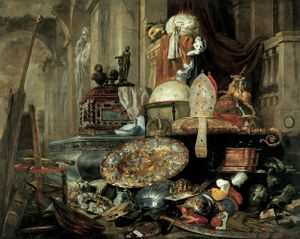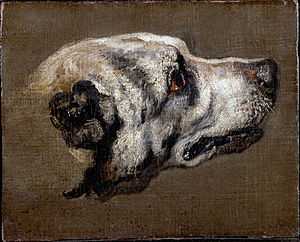Pieter Boel

Pieter Boel or Peeter Boel (1626–1674) was a Flemish painter who specialised in lavish still lifes and animal paintings. He moved to Paris where he worked in the gobelin factory and became a painter to the king.
Life
He was born into a family of artists in Antwerp. He was the son of the engraver Jan Boel and the brother of engraver Quirin Boel II. His teachers were his father and Jan Fijt, a well-known landscape and animal painter. He was registered in the Antwerp Guild of Saint Luke as a wijnmeester (wine master) (a title reserved for the children of members of the guild ) in 1650-51 . He probably traveled to Italy in the 1640s or in 1651.[1][2] His trip brought him to Genoa and Rome. In Genoa he stayed with his uncle, the painter and art dealer Cornelis de Wael who had established himself in that city.[2]
After 1668 he moved to Paris. Here he worked for Charles Le Brun in his first tapestry workshop.[1] He was appointed paintre ordinaire by King Louis XIV in 1674, but died in September of that year.[2]
He was the father of Jan Baptist (II) and Balthasar-Lucas Boel. He was the teacher of his sons and David de Koninck.[1][2]
Work

He principally painted still lifes including flower still lifes, hunting still lifes, animal and fish still lifes, vanitas paintings and still lifes of weapons. He also painted some landscapes.[1] Since most of his works are undated, it is difficult to establish a chronology for his work. He follows to a large extent the style of his teacher Jan Fijt, in particular in his smaller compositions featuring a hare or a few birds in the open air. Boel's compositions differ from Fijt's works in their restraint and the smoother and more controlled handling of the paint. His palette also differs from Fijt's in his preference for accents of blue, red and pink.[2]
Boel was accomplished in large-scale vanitas paintings depicting an abundance of fruit, flowers, game and precious objects. His masterpiece in this genre is the Vanitas Still Life in the Palais des Beaux-Arts de Lille.[2]
Pieter Boel is said to have revolutionized animal painting. Whereas artists had contented themselves before with making static studies from stuffed animals, Boel drew and painted his animals from life in the menagerie at Versailles. He thus represented animals in their natural poses. His naturalism influenced a long line of great animal artists, from the painter Jean-Baptiste Oudry to the sculptor Antoine-Louis Barye.[3] Boel was particularly adapt at rendering various textures, especially feathers.[2]
His animal studies were used as models for the animals in the foreground of a large tapestry, referred to as 'The Months' or 'The Royal Houses'.[3] The French painter François Desportes copied several of his paintings and as a result, it was believed that the original drawings were by Desportes. It is only after it was confirmed that the originals had been made by Boel that Boel's reputation as an animal painter was re-established.[4]
References

- ↑ 1.0 1.1 1.2 1.3 Biographical details at the Netherlands Institute for Art History (Dutch)
- ↑ 2.0 2.1 2.2 2.3 2.4 2.5 2.6 Peeter Boel at site of Johnny Van Haeften Ltd.
- ↑ 3.0 3.1 Adeline Collange, 'Study of a Crowned Crane'
- ↑ Pieter Boel, Painter of Louis XIV's Animals - The collection of painted studies from the Gobelins
External links
| Wikimedia Commons has media related to Pieter Boel. |
- Peeter Boel in: Cornelis de Bie, Het Gulden Cabinet van de Edel Vry Schilderconst, 1718 (Dutch)
- Peter Boel biography in: Arnold Houbraken, De groote schouburgh der Nederlantsche konstschilders en schilderessen, 1718 (Dutch)